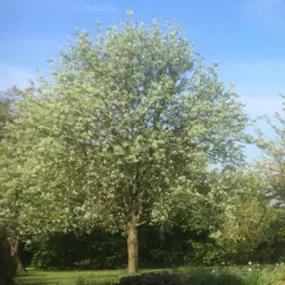Whitebeam Sapling Trees
Honest Delivery PricesSorbus aria
Sapling Trees- Native tree. Leaves have silver undersides.
- Sizes: Saplings & Standard Trees.
- Not suitable for hedging. Good tall screening.
- Max. Height: 15m
- Bareroot Delivery Only: Nov-Mar.
Description
Whitebeam Plants - Sapling Trees
Delivered by Mail Order Direct from our Nursery with a Year Guarantee
Whitebeam, Sorbus aria, is a medium sized native tree.
Whitebeam is not suitable for a clipped hedge.
It can be grown as a screening tree up to about 15 metres high. It is a good windbreak tree.
The plants on this page are young saplings. You can also buy larger Whitebeam trees here.
Browse all of our other varieties of Whitebeam Trees.
Whitebeam saplings are only delivered bareroot, during winter (Nov-March).
All of our young trees and shrubs are measured by their height in centimetres above the ground (the roots aren't measured).
General description of Sorbus aria plants:
Whitebeam is a medium sized, deciduous native tree. Its deep green mature leaves start off covered in fine white-grey hairs, which remain on the undersides of the leaves. They turn a beautiful russet brown in the autumn. White flowers are produced in the summer, followed by red fruit in the autumn - much loved by birds. Sorbus aria is a splendid avenue tree.
Planting Instructions
Notes on planting Whitebeam:
The Whitebeam grows well by the sea and in any well-drained soil, including chalk.
Prepare your site before planting:
It is good to dig over the area where you intend to plant several months in advance. Destroy the weeds first: nettles, brambles and ground elder are tough. Then dig the soil over; remove rocks, roots and other rubbish. Mix in well rotted compost or manure down to the depth of about 2 spades.
If you have a heavy clay soil, it might be too difficult to dig over for most of the year. Heavy clay is fertile soil, so you don't really need to improve it; killing the weeds is still necessary.
Remember to water establishing plants during dry weather for at least a year after planting.
Planting accessories:
Prepare your site for planting by killing the weeds and grass.
If you are planting in an area with rabbit and/or deer, you will need to use a protective plastic spiral for each plant, supported by a bamboo cane.
If your soil quality is poor, we recommend using mycorrhizal "friendly fungi" on the roots of new trees and shrubs.
After Care
After you plant your trees, the most important thing to do is water them in dry weather. You will also need to weed around the plants. Both of these will be necessary for at least a year after planting.
Water thoroughly but not too often: let the soil get close to drying out before watering your plants again.
Special notes on caring for Whitebeam:
Whitebeam is a very tough plant that shouldn't need special attention once it has established. If pruning is necessary, it is best do it in winter. Always hire a tree surgeon to remove large branches.
Hygiene & Diseases:
Dead, damaged or diseased wood can be pruned off as soon as it appears.
Disinfect your pruning tools between every cut if there is any sign of disease.
Burn or dispose of any diseased material, do not compost it.
After you plant your trees, the most important thing to do is water them in dry weather. You will also need to weed around the plants. Both of these will be necessary for at least a year after planting.
Water thoroughly but not too often: let the soil get close to drying out before watering your plants again.
Special notes on caring for Whitebeam:
Whitebeam is a very tough plant that shouldn't need special attention once it has established. If pruning is necessary, it is best do it in winter. Always hire a tree surgeon to remove large branches.
Hygiene & Diseases:
Dead, damaged or diseased wood can be pruned off as soon as it appears.
Disinfect your pruning tools between every cut if there is any sign of disease.
Burn or dispose of any diseased material, do not compost it.


